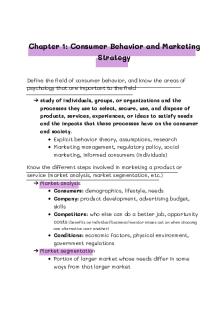Consumer Perception PDF

| Title | Consumer Perception |
|---|---|
| Course | Consumer Behaviour |
| Institution | Macquarie University |
| Pages | 5 |
| File Size | 266.6 KB |
| File Type | |
| Total Downloads | 69 |
| Total Views | 153 |
Summary
Download Consumer Perception PDF
Description
MKTG1003 – CONSUMER BEHAVIOUR WEEK 6 – CONSUMER PERCEPTION Defining Perception The process by which sensations are selected, organised and interpreted (Solomon et al. 2007, p. 40) The study of perception focuses on what consumers add (cognitively, affectively and behaviourally) to the stimuli in order to give them meaning How we interpret the signals and stimuli around us in terms of our rational evaluation, emotional state and our behaviour Perception is about giving meaning to the things that surround us The Importance of Perception in Consumer Behaviour To truly, and permanently, change a customer’s buying behaviour, you first need to change their perception of your company, products and services A change in perception can lead to a permanent change in behaviour It is crucial for brands to think about all of the stimuli and the cues that are not only in their physical product, their packaging, their copy lines, their advertising and campaigns/imagery they show, but also in stores and store layout – retail look and feel – all impact on consumer perception leading consumers to feel positive, negative or possibly neutral about the brand
SENSORY DYNAMICS OF PERCEPTION Perception is defined as the process by which an individual receives, selects and interprets stimuli to form a meaningful and coherent picture of the world (a stimulus is any unit of input to any of the senses) Two individuals can be exposed to the same stimuli under the same conditions, but can react differently based upon their own needs, wants and expectations
Overview of Perception Process
Influence on Consumers Colour and shape draw attention of 92.6% of the population when buying products (Market Research Expo, 2004) We make our FIRST impressions in 90-seconds – between 62-90% of that impression is based on colour (institute for Colour Research, 2010) Hearing, smelling and sense of touch are 2 nd most important with 5.6% According to research, ads in colour are read 42% more than the same ads in black and white (White, 1997) Sensation Sensation is the immediate and direct response of the sensory organs to simple stimuli (such as an ad or packaging) These include the: ears, eyes, nose, mouth, skin Sensory Systems: VISION Marketers rely heavily on visual elements in advertising, store design, and packaging Meanings are communicated on the visual channel through a product’s colour, size and styling Colours may influence our emotions more directly – arousal and stimulated appetite (e.g. red), relaxation (e.g. blue)
Sensory Systems: SMELL
Has a powerful impact on consumer interpretations of the products and services they are purchasing and shapes our limbic system (one of the most primitive elements of our mind) Odours can stir emotions or create a calmly feeling – tells us how to feel on a subconscious level Scent is used for strategic purposes to shape consumer perceptions of the brand offering and to also enhance emotional recall and familiarity when creating customer loyalty Some responses to scent result from early associations that arouse good or bad feelings Marketers are finding ways to use smell: – Scented clothes, stores, cars and planes, household products and advertisements Sensory Systems: SOUND Advertising jingles create brand awareness Background music creates desired moods and can shape the tempo of our shopping Sound directly affects people’s feelings and behaviours Muzak uses a system called “stimulus progression” to increase the normally slower tempo of workers during mid-morning and mid-afternoon time slots Sensory Systems: TOUCH Common observation tells us that this sensory channel and the effects of tactile stimulation is extremely important People associate textures of fabrics and other surfaces with good quality Perceived richness or quality of the material in clothing is linked to its ‘feel’, whether it is rough or smooth What is the Servicescape – Bitner The impact of the environmental dimensions which relay the five senses
TREE ELEMENTS OF PERCEPTION Exposure Occurs when a stimulus comes within the rand of someone’s sensory receptors Consumers concentrate on some stimuli, are unaware of others, and even go out of their way to ignore some messages Attention The extent to which processing activity is devoted to a particular stimulus Our brain’s capacity to process information is limited – people cannot pay attention to every stimulus they are exposed to Interpretation How we make meaning of the stimuli we have received What meaning have we made from the stimuli How does this effect how we behave Important Selective Perception Concepts Selective Exposure
Consumers seek out messages they find pleasant and avoid painful or threatening ones
Selective Attention
Consumers exercise a great deal of selectivity in the amount of attention they give to stimuli
Perceptual Defence
Consumers screen out stimuli that are important for them not to see, even though exposure has taken place
Perceptual Blocking
Consumers protect themselves from being bombarded with stimuli by simply ‘tuning out’
Perceptual Positioning Strategy A fundamental part of a company’s marketing efforts as it uses elements of the marketing mix to influence the consumer’s interpretation of its meaning Positioning is entirely psychological and is about precisely manipulating consumers’ perceptions and the five senses in order to create a unique position for them the brand in the consumers mind, which sets that particular brand a part from competitors in the market Many dimensions can establish a brand’s position in the marketplace – lifestyle, price leadership, attributes, product class, competitors, occasions, users, quality, etc. Consumer Imagery – Positioning and Repositioning Proucts and Services Positioning is the image that a product or service has in the mind of the consumer
Positioning conveys the concept or meaning of the product, in terms of how it fulfils a consumer need Consumers may rely more on the image conveyed by the brand than its actual attributes...
Similar Free PDFs

Consumer Perception
- 5 Pages

Perception
- 3 Pages

PERCEPTION
- 10 Pages

Pain perception
- 32 Pages

Consumer surplus
- 4 Pages

Consumer behavior
- 5 Pages

Consumer Arithmetic
- 8 Pages

Consumer behaviour
- 17 Pages

Consumer behaviour
- 16 Pages

Consumer Behavior
- 33 Pages

Consumer Behaviour
- 2 Pages
Popular Institutions
- Tinajero National High School - Annex
- Politeknik Caltex Riau
- Yokohama City University
- SGT University
- University of Al-Qadisiyah
- Divine Word College of Vigan
- Techniek College Rotterdam
- Universidade de Santiago
- Universiti Teknologi MARA Cawangan Johor Kampus Pasir Gudang
- Poltekkes Kemenkes Yogyakarta
- Baguio City National High School
- Colegio san marcos
- preparatoria uno
- Centro de Bachillerato Tecnológico Industrial y de Servicios No. 107
- Dalian Maritime University
- Quang Trung Secondary School
- Colegio Tecnológico en Informática
- Corporación Regional de Educación Superior
- Grupo CEDVA
- Dar Al Uloom University
- Centro de Estudios Preuniversitarios de la Universidad Nacional de Ingeniería
- 上智大学
- Aakash International School, Nuna Majara
- San Felipe Neri Catholic School
- Kang Chiao International School - New Taipei City
- Misamis Occidental National High School
- Institución Educativa Escuela Normal Juan Ladrilleros
- Kolehiyo ng Pantukan
- Batanes State College
- Instituto Continental
- Sekolah Menengah Kejuruan Kesehatan Kaltara (Tarakan)
- Colegio de La Inmaculada Concepcion - Cebu




